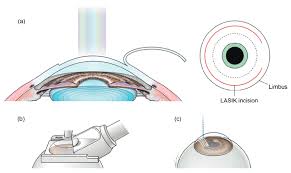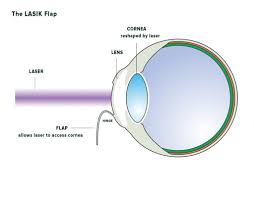Table of Contents
ToggleFor many contemplating LASIK surgery, the allure of clear vision without the hassle of glasses or contact lenses is incredibly appealing.
LASIK has transformed the landscape of vision correction, offering a secure and remarkably efficient technique that has enhanced the lives of millions.
However, one question that often arises among potential patients and those who have already undergone the procedure is whether LASIK surgery can be repeated.
In this detailed guide, we’ll explore the feasibility of undergoing LASIK surgery more than once, factors to consider, and what the research says, aiming to provide valuable insights for LASIK patients, eye care enthusiasts, and anyone interested in the realm of health and wellness.
Understanding LASIK and Its Longevity
LASIK (Laser-Assisted In Situ Keratomileusis) is a surgical procedure designed to correct common vision problems such as myopia (nearsightedness), hyperopia (farsightedness), and astigmatism. By reshaping the cornea, LASIK can dramatically improve visual acuity, with many patients achieving 20/20 vision or better.
The outcomes of LASIK surgery are designed to last a lifetime. However, it’s crucial to acknowledge that our eyes and vision can change over time due to age, health conditions, and other factors. These changes might lead some individuals to consider a second procedure.
Can LASIK Surgery Be Repeated?
Yes, LASIK surgery can be repeated, but it’s not as straightforward as undergoing the initial procedure.
This process, often referred to as a LASIK enhancement or touch-up, is considered for patients whose vision has changed significantly since their first surgery or for those who did not achieve the desired outcome.
Factors to Consider
Before deciding on repeat LASIK surgery, several critical factors must be evaluated:
- Corneal Thickness: One of the critical considerations is the thickness of the cornea. LASIK surgery involves removing corneal tissue to reshape the eye’s surface. For a repeat procedure, there must be sufficient corneal thickness to ensure the eye’s structure remains stable and healthy.
- Stability of Vision: Doctors typically recommend that a patient’s vision should be stable for at least a year before considering a repeat LASIK procedure.
- Eye Health: Overall eye health is paramount. Conditions such as corneal scarring or irregularities, severe dry eye syndrome, or other eye diseases could affect the feasibility and safety of undergoing another LASIK procedure.
- Patient Age: Age-related changes in vision, particularly the development of presbyopia (difficulty focusing on close objects) in individuals over 40, may influence the decision and expected outcomes of a repeat LASIK surgery.
- Time Since First Surgery: While there’s no universal waiting period, many surgeons suggest waiting at least 3 to 6 months after the initial LASIK surgery before considering an enhancement, allowing the eyes ample time to heal and vision to stabilise.
When Might LASIK Be Repeated?
There are several scenarios where a patient might contemplate undergoing LASIK surgery again:
- Undercorrection or Overcorrection: Sometimes, the initial surgery may not achieve the desired level of correction. This could be due to various factors, including the healing process and how the individual’s eye responds to the surgery.
- Vision Changes: As we age, our eyes can naturally change, leading to shifts in vision. This is particularly common for individuals who undergo LASIK at a younger age.
- Presbyopia: This age-related condition affects our ability to focus on close objects and is something that LASIK cannot prevent. Individuals might seek additional treatments to address vision changes caused by presbyopia.
The LASIK Enhancement Procedure
A LASIK enhancement follows a similar procedure to the initial surgery.
The surgeon will assess the patient’s current vision and eye health to develop a tailored treatment plan. The enhancement aims to fine-tune the vision correction, addressing any residual refractive error that has developed since the first surgery.
What to Expect
Patients considering a LASIK enhancement can expect several key steps:
- Comprehensive Eye Examination: A thorough evaluation is essential to determine eligibility for a repeat LASIK. This examination includes assessing corneal thickness, eye health, and the extent of the refractive error.
- Discussion of Expectations: It’s crucial for patients to discuss their vision goals and expectations with their surgeon. This conversation helps ensure that a LASIK enhancement is aligned with the patient’s needs and lifestyle.
- The Enhancement Procedure: If deemed a suitable candidate, the patient will undergo the LASIK enhancement, which typically involves lifting the original corneal flap created during the first surgery. The surgeon then uses the laser to make the necessary adjustments to the corneal shape.
- Recovery: The recovery process after a LASIK enhancement is generally similar to the initial surgery, with most patients experiencing rapid visual improvement and minimal discomfort.
Risks and Considerations
While LASIK enhancements can be successful, it’s important to understand the risks associated with repeating the surgery. These risks include:
- Increased Chance of Dry Eyes: Any LASIK procedure can exacerbate dry eye symptoms, and the risk may increase with additional surgeries.
- Potential for Complications: Although rare, complications such as infection, inflammation, and issues with the corneal flap can occur.
- Vision Quality: There’s a chance that the enhancement may not fully correct vision issues, leading to the need for glasses or contact lenses.
Alternatives to Repeating LASIK
For those who may not be candidates for a second LASIK surgery or are looking for other options, several alternatives exist:
- PRK (Photorefractive Keratectomy): This procedure is similar to LASIK but without creating a corneal flap. It’s often considered for individuals with thinner corneas.
- Refractive Lens Exchange (RLE): RLE involves replacing the eye’s natural lens with an artificial one, a process similar to cataract surgery. This can be an option for individuals with presbyopia or significant vision changes.
- Implantable Collamer Lens (ICL): This involves placing a corrective lens inside the eye, which can be an alternative for those with high levels of myopia.
What the Research Says
Studies on repeat LASIK surgeries indicate that enhancements can be safely performed and can significantly improve visual acuity.
However, the need for a second surgery is relatively rare, with most studies suggesting that only about 2% to 10% of LASIK patients require an enhancement.
Making the Decision
For those considering repeat LASIK surgery, the decision should be made in consultation with a qualified eye surgeon who can assess the specific circumstances of your case.
Factors such as the reason for the initial surgery, current vision needs, and long-term eye health should all be part of the discussion.
To Sum Up
While LASIK surgery can indeed be repeated, the decision to undergo a LASIK enhancement should not be taken lightly. It requires careful consideration of various factors, including the health of your eyes, the reasons for seeking an enhancement, and the potential risks involved. With advancements in technology and surgical techniques, repeat LASIK surgeries have become safer and more effective, offering hope for those seeking further improvements in their vision.
If you’re contemplating a LASIK enhancement, it’s essential to consult with a reputable and experienced eye surgeon who can provide personalised advice and help you make an informed decision.
Remember, the goal of any vision correction procedure is to improve your quality of life through better vision, and a thorough understanding of the options available to you is the first step in achieving that goal.













